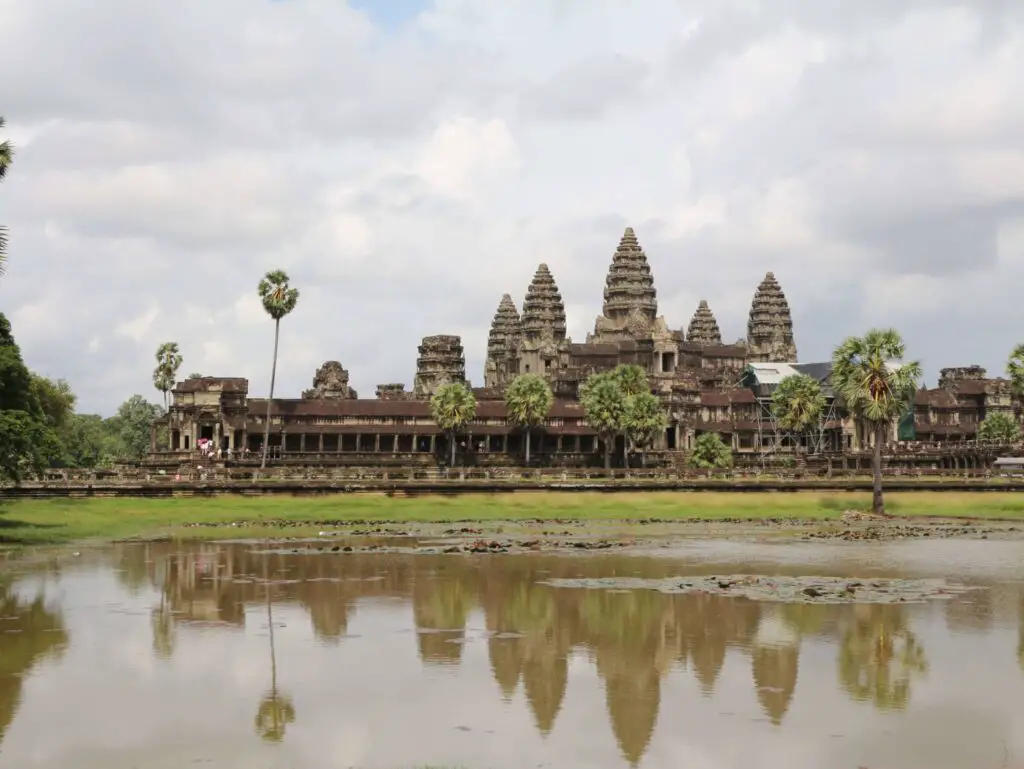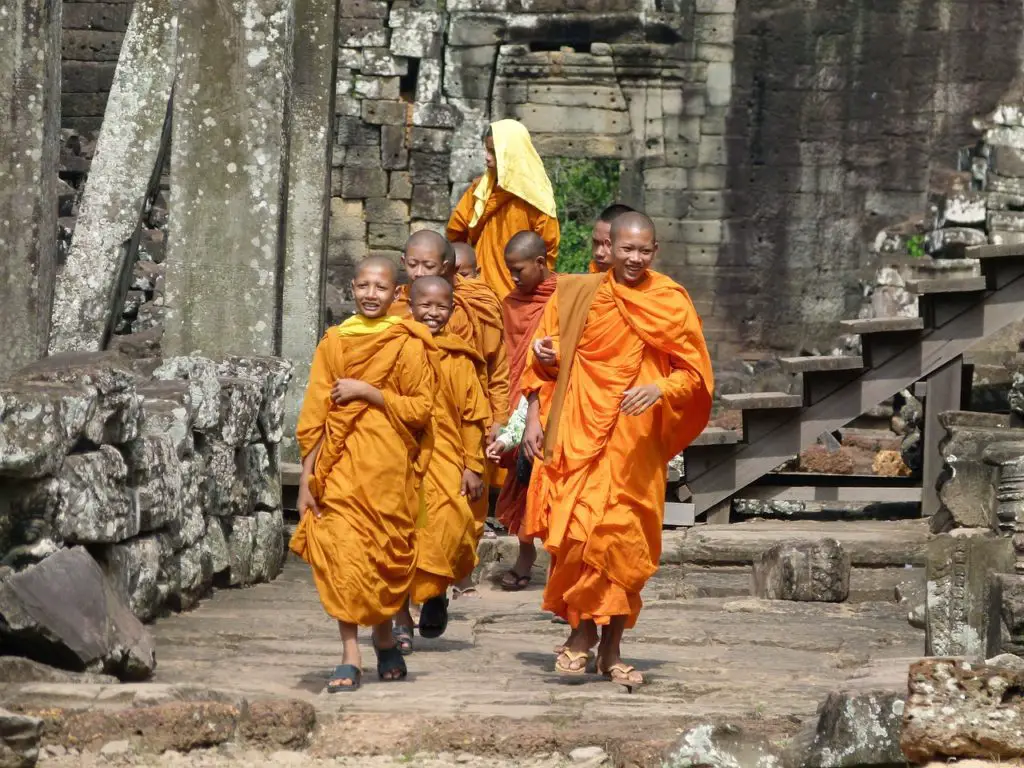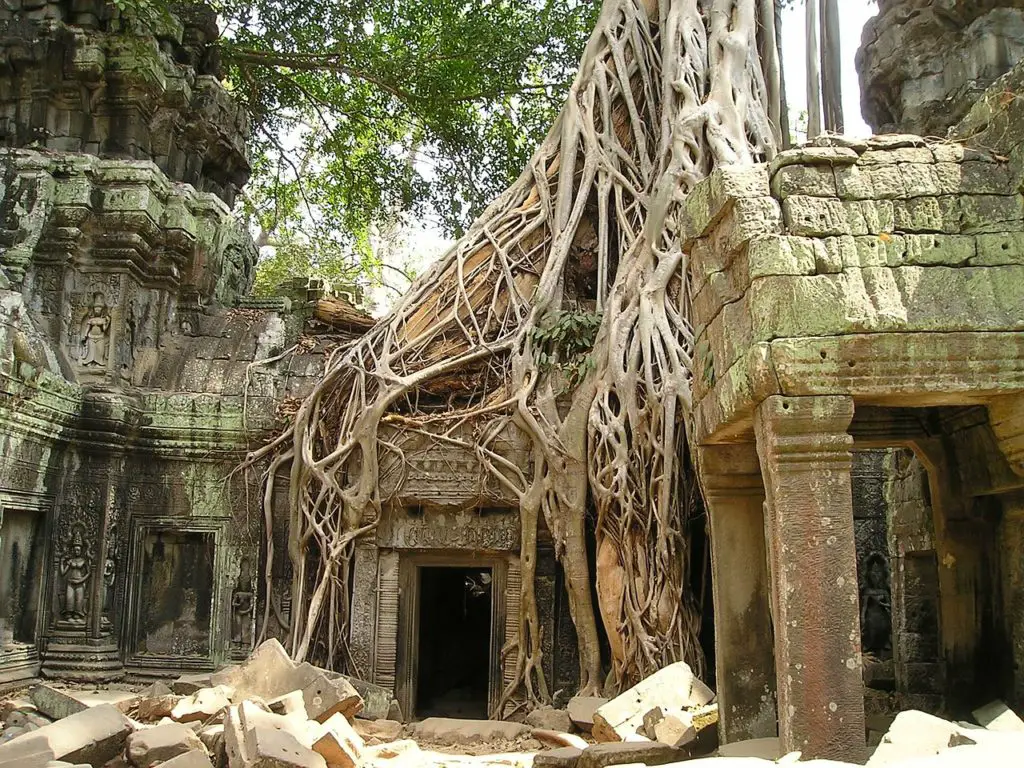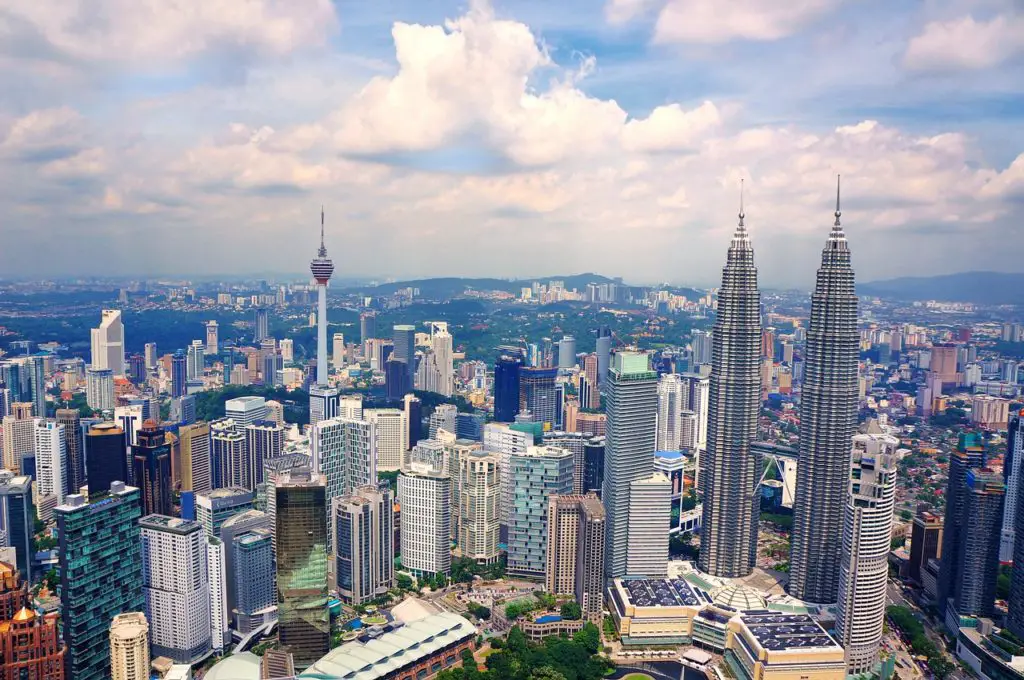Are you looking for reasons to visit Angkor Wat?
Here are our 13 reasons to visit Angkor Wat at least once in your lifetime. We visited Angkor Wat on our maiden trip to Siem Reap and we loved it.
Angkor Wat is a masterpiece located in the heart of Cambodia’s Siem Reap province. Known as the jewel of Khmer architecture, it’s the world’s largest religious monument.
Its intricate design and rich history make it a must-visit destination for any traveler, especially those interested in Southeast Asia. The temple complex was built by King Suryavarman II and was originally dedicated to the Hindu god Vishnu.
The towering spires and intricate bas-reliefs depict scenes from Hindu epics like the Ramayana and the Mahabharata. The attention to detail is inspiring. And, as you wander through the corridors and galleries, you’ll capture countless photo opportunities to captivate your readers.
What’s truly fascinating about Angkor Wat is the seamless fusion of Hindu and Buddhist elements. In the 14th century, it was converted into a Buddhist temple, which added depth to its cultural significance. The central spire represents the mythical Mount Meru, the home of the gods in Hindu cosmology. While the bas-reliefs tell stories from the life of Buddha.
Disclaimer: Some of the links here are my affiliate links and I may earn if you click on them, at no extra cost to you. Thank you for supporting my blog!
Are you dreading to walk all over Angkor Wat with your old walking shoes? Fret not! Get these walking shoes which comes with a soft leather upper and midsole to provide comfort. With its high abrasion outsole, these shoes are durable for daily usage and can be worn by both men and women alike.
Why not learn to cook traditional Cambodian dishes? Begin your lesson with a visit to the market and learn all about Cambodian vegetables. And, the best part is that you can recreate this 3-course meal recipe at home.
Join a guided food tour in Siem Reap to discover the tastes of Cambodia. Try authentic Cambodian cuisine, explore night markets, and enjoy whisky tasting at Sombai.
Visit Phnom Kulen National Park and explore the birthplace of the Angkor Empire. Ascend to the top of Kulen Mountain for spectacular views, then relax at the waterfall and enjoy a picnic.
If you are looking for a unique experience, consider floating in the world’s largest helium balloon and enjoying a breathtaking birds-eye view of Angkor Wat from a gondola at a staggering height. This is an unforgettable way to see one of the world’s most iconic landmarks and appreciate its beauty in a whole new way.
Explore Kulen Mountain, waterfalls, and Beng Melea temple on a full-day guided tour from Siem Reap. Experience rural life in Kampong Phluk floating village by boat. Immerse yourself in Cambodian culture and nature on this enriching adventure.
1. Architectural marvel
The architectural marvel of Angkor Wat was one of the reasons we made this trip to Siem Reap. And, we were immediately struck by the sheer size and grandeur of Angkor Wat. The temple is a true architectural marvel and a masterpiece that is a testament to the Khmer Empire’s rich history.
As we approached the temple, we were impressed by the intricate carvings and bas-reliefs that adorned its walls. The carvings depicted scenes from Hindu mythology and provided a glimpse into the religious beliefs of the Khmer people.
Constructed in the 12th century by King Suryavarman II, the temple’s architecture is a stunning blend of Khmer and Hindu influences. The central tower, which represents the mythical Mount Meru, is the most recognizable feature of the temple. The five soaring towers surrounding it symbolize the peaks of this sacred mountain, creating a truly mesmerizing sight.
As we walked around the temple, we admired the intricate details of the carvings and sculptures that adorned its walls and pillars. There were hidden chambers, libraries, and courtyards that were filled with ancient artifacts and relics.
The temple’s layout is meticulously designed to align with astronomical principles and the Khmer’s spiritual beliefs. We learned that the temple was not just a place of worship but also served as a center for education and knowledge.
Angkor Wat was an unforgettable experience that left a lasting impression on us. The temple is a living piece of art, and we were amazed by the incredible craftsmanship and engineering skills of the people who brought it to life.
Read more
- Your Ultimate Guide To 3 Days In Siem Reap
- Interesting Places In Siem Reap: Top 5
- 2 Days In Phnom Penh Itinerary: A Complete Guide
2. Historical significance
Angkor Wat was built in the early 12th century by King Suryavarman II with this sprawling masterpiece standing as a symbol of Khmer architectural brilliance and Hindu-Buddhist culture.
For history lovers, the historical significance is one of the reasons to visit Angkor Wat. At its core, Angkor Wat is a fusion of religion and architecture.
Originally dedicated to the Hindu god Vishnu, its five towering central spires represent the five peaks of Mount Meru, a sacred mountain in Hindu mythology.
However, over the centuries, it transformed into a Buddhist temple, highlighting the fluidity of spiritual beliefs in the region. Historically, Angkor Wat served as the political and religious center of the Khmer Empire.
Its intricate bas-reliefs depict epic tales of Hindu mythology and scenes from the Khmer Empire, offering valuable insights into the culture and life of that era. The vast moat surrounding the temple served both as a protective measure and as a symbol of the cosmic ocean, separating the mortal world from the divine.
The decline of Angkor Wat and the Khmer Empire can be attributed to factors such as shifting political powers and environmental changes. The temple was eventually hidden by the dense jungle until its rediscovery in the 19th century, capturing the imagination of the world.
Today, Angkor Wat stands as a UNESCO World Heritage Site, drawing millions of travelers and historians. Exploring its intricacies allows one to step back in time and unravel the rich history of Cambodia.
3. Sunrise over Angkor
While this is a bucket list for many who visit Angkor Wat, we did not join the bandwagon of early birds to get the stunning sunrise photos you see across the web. We visited Siem Reap during the monsoon season and it was raining the night before, clearly, sleep was more important.
However, we did take a reflection photo at the reflection pond in the afternoon and we managed to get a good photo minus the crowds.
Now, the best time to get beautiful sunrise photos of Angkor Wat is during the dry season from November to March. The monsoon season is from May to November which brings rainy nights and cloudy skies.
If getting the perfect sunrise over Angkor is one of your reasons to visit Angkor Wat, we advise that you reach Angkor Wat by 5 a.m. You will need a ticket to enter Angkor Wat and to avoid delays, it is best to check the sunrise time and weather before making the trip.
4. Intricate bas-reliefs
Another one of our reasons for visiting Angkor Wat was its intricate bas reliefs. These beautiful carvings line the inner walls of the outer galleries. The first bas relief is the Battle of Kurukshetra which is based on the Hindu epic, Mahabharat.
The bas relief shows the battle between the Pandavas and Kauravas. From the advancing Kaurava armies to the death of Bhisma. To make things clearer, the Pandava armies are moving from right to left while the Kaurava armies move from left to right.
However, it is the Churning of the Sea of Milk bas relief at the southern section of the eastern gallery which shows 92 asuras and 88 devas using Vasuki to churn the sea under Lord Vishnu’s direction.
Unlike other bas reliefs, the characters in the churning of the sea of milk are clear which makes it the easiest to identify and understand.
The other bas reliefs are the historic procession of Suryavarman II and the three tiers of 32 hells and 37 heavens with Lord Yama (the Hindu God of Death) sitting on his vehicle, the bull while the sinners receive their punishment at the lowest tier of the bas relief.
5. Breathtaking views
If the above four reasons to visit Angkor Wat are not enough, will this view from the top tier of the temple change your mind?
Instead of joining the bustling crowd to catch the sunrise at Angkor, which was not on our agenda, we decided to take a different route by ascending to the upper levels of the ruins. The journey was challenging, but the effort was worth it as we were rewarded with an unparalleled and breathtaking view.
The panoramic views of the ruins set amidst the dense forest were truly mesmerizing. The intricate details of the temple complex were visible from a bird’s eye view. We were able to observe the fine carvings and intricate details that adorned the walls and pillars of the ruins.
The contrast between the ancient ruins and the lush greenery surrounding them was a sight to behold. We highly recommend spending some time at the upper levels as there were far fewer visitors, which made the experience all the more enjoyable.
We were able to take our time and appreciate the beauty of the ruins without feeling rushed or crowded. It was a peaceful experience that left us feeling rejuvenated and in awe of the historical and natural beauty surrounding us.
6. Spiritual connection
A spiritual connection during our visit to Angkor Wat is one of our other reasons to visit Angkor Wat. We feel a spiritual connection when we are in harmony with our surroundings, whether it is the culture, history, or natural beauty of a place that makes us feel this way.
Angkor Wat is a temple that holds a lot of spiritual significance because of its design and symbolism. The temple’s architecture represents the cosmic world in Hindu cosmology, with Mount Meru at the center, which is believed to be the abode of the gods.
As you wander around the temple, you’ll see carvings and sculptures that tell stories from Hindu and Buddhist mythology. These works of art give you an insight into the religious beliefs and tales of ancient Khmer culture.
Our truly spiritual moment was the pockets of peace that we found throughout the temple. Angkor Wat is huge and finding serene spots to simply admire the monument or nature had a calming effect on us.
7. Angkor Thom
If you’re planning a trip to Siem Reap, Cambodia, make sure to add Angkor Thom to your list of must-see places. This ancient city was the last and most important capital of the Khmer Empire and is famous for its incredible architecture and fascinating history.
The South Gate of Angkor Thom is one of the reasons to visit Angkor Wat. The gate is adorned with cool stone faces that grab your attention. Once inside, don’t miss the Bayon Temple, which is famous for its mysterious stone faces that seem to be watching you from every angle.
The Baphuon Temple is another amazing structure that will leave you in awe of the Khmer people’s architectural skills. And, of course, you’ll want to check out the Terrace of the Elephants and the Terrace of the Leper King, which are both interesting.
But it’s not all about the temples and structures. You’ll be surrounded by lush greenery and beautiful landscapes that make Angkor Thom a great place to relax and soak up the atmosphere. It’s the perfect place to learn about Cambodia’s rich history and culture while enjoying some well-deserved downtime.
8. Ta Prohm
Lara Croft and the Tomb Raider and Ta Prohm are one of the many reasons to visit Angkor Wat. Ta Prohm is an awe-inspiring temple located in the Angkor Archaeological Park in Cambodia. It’s a true marvel of ancient architecture and nature’s relentless reclamation.
This temple is often referred to as the “Tomb Raider Temple” because it was featured in the popular movie starring Angelina Jolie. Ta Prohm was built in the 12th century by King Jayavarman VII and was originally dedicated to his mother.
What makes it unique is that it has been left largely in its natural state, with towering trees and massive roots engulfing the temple structures. The intertwining of nature and beautiful architecture creates a hauntingly beautiful scene, making it a must-visit for any traveler.
What we loved about this temple was the mystical ambiance and the striking contrast between the ancient ruins and the surrounding jungle. The best time to visit this temple is either early in the morning or late in the afternoon to avoid the crowds and make the most of the magical lighting for photography.
9. Experience the local culture
Do you need more reasons to visit Angkor Wat?
During our travels to Cambodia, we were captivated by the rich and diverse cultural tapestry of this beautiful country. One of the first things that struck us was the warm and welcoming nature of the Cambodian people.
They have a genuine hospitality that makes you feel right at home. Whether you’re exploring the bustling streets of Phnom Penh or the serene temples of Siem Reap, we were met with friendly smiles and helpful gestures.
The heart of Cambodian culture is undoubtedly its ancient temples, with Angkor Wat being the most iconic. On our trip to the temples of Angkor, we witnessed the incredible fusion of Hindu and Buddhist influences. The intricate carvings and stunning architecture of these temples gave us a glimpse into the country’s history and spirituality.
Cambodian cuisine is a treat for the taste buds. Don’t miss the chance to try dishes like Amok (a delicious coconut curry), Lok Lak (marinated beef), and, of course, the famous fish amok. While Psar Chas (Old Market) caters to the mass tourist market, the Angkor Night Market remains the city’s top night market.
The Cambodian culture is also deeply rooted in its traditional arts, including Apsara dance, which is a mesmerizing form of classical dance. Attending a performance is a must to appreciate the grace and storytelling that this art form conveys.
Finally, when visiting Cambodia, it’s important to be respectful of local customs and traditions. Dress modestly when visiting religious sites and show respect to the locals you meet along your journey.
10. Adventure opportunities
To break the circuit of visiting temples, we recommend other activities in and around Angkor Wat, why not join a quad-bike tour while enjoying Siem Reap’s beautiful countryside? Or, join the sunrise bike tour that takes you to the back trails of Angkor.
For a unique experience, visit Angkor Wat and its surrounding temples in a classic vintage jeep tour and avoid crowds using tuk-tuks and buses. There are plenty of adventurous opportunities around Angkor Wat, though it was not one of our many reasons to visit Angkor Wat.
11. Photographer’s paradise
As you step into the ancient city of Angkor, you will be transported to a world of wonder, and at the heart of it lies the magnificent Angkor Wat – a photographer’s paradise. The temple complex is a visual treat, with its intricate architecture, intricate carvings, and grand structures, all providing a captivating backdrop for any photographer.
At sunrise or sunset, the temple is bathed in a golden light, casting an ethereal glow that envelops the entire complex. The play of light and shadows creates a mesmerizing spectacle that is a feast for the eyes.
As you capture the reflection of Angkor Wat in the nearby ponds, you’ll be transported to a magical world that is beyond words. As you venture deeper into the complex, you’ll discover hidden corners and ancient ruins that tell tales of a bygone era.
The temples within the Angkor complex offer unique frames that showcase the rich cultural and historical aspects of Cambodia. Each temple has its own story to tell, and as you explore, you’ll be able to capture these stories through your lens.
To capture the best shots, it’s best to visit Angkor Wat at different times of the day. The soft morning light and the warm tones during the golden hour offer distinct atmospheres that can add variety to your photo collection.
Whether you’re an avid photographer or just someone who appreciates the beauty of the world, Angkor Wat is a place that will leave you spellbound.
12. Conservation efforts
Angkor Wat is not only a stunning architectural marvel but also a site of significant conservation efforts. The complex faces challenges such as weathering, structural instability, and environmental factors, prompting the Cambodian authorities to take measures to preserve this cultural treasure.
One notable initiative involves regular maintenance and restoration work carried out by the Apsara Authority, which oversees the management of Angkor. With teams of over 100 full-time conservation technicians, the knowledge of restoration has now spread to the younger generation.
Additionally, there are efforts to address issues like vegetation overgrowth and water damage. Collaborative projects with international organizations and experts bring diverse perspectives to the conservation table.
The aim is not only to protect the physical structures but also to ensure sustainable tourism that minimizes the impact on this ancient site. By visiting Angkor Wat, you contribute to the conservation efforts of this beautiful temple.
13. Magical atmosphere
The atmosphere at Angkor Wat is truly magical and awe-inspiring. As we approached the temple complex, we felt a sense of reverence and wonder in the air. The sprawling temple complex is surrounded by lush greenery, creating a peaceful and serene environment.
As we entered the temple, we were struck by the intricate carvings and bas-reliefs that adorn its walls. The carvings depict scenes from Hindu mythology and provide a glimpse into the religious beliefs of the Khmer people. The intricate details and precision of the carvings are truly remarkable and left us in awe.
We wandered through the corridors and galleries, the atmosphere was one of tranquility and calmness. The temple’s vast size allowed us to find peaceful solitude within its walls, creating a meditative and introspective experience.
Watching the sunrise or sunset over the temple complex is an unforgettable experience. The reflection of the temple in the surrounding moat creates a serene and picturesque scene.
The changing colors of the sky, from soft pinks to vibrant oranges and reds, create a magical and ethereal atmosphere. The atmosphere at Angkor Wat is one of reverence, wonder, and tranquility. The temple complex is a true masterpiece and a testament to the Khmer Empire’s rich history and cultural heritage.
Our Verdict
Exploring Angkor Wat is like stepping into a timeless realm where history whispers through ancient stone corridors and magnificent temples. The 13 reasons to visit this UNESCO World Heritage site paint a vivid picture of its allure.
From the mesmerizing sunrise over Angkor Wat itself to the intricate carvings at Bayon, each moment is a journey back in time. The spiritual ambiance of Ta Prohm, entwined with nature, adds a unique charm. Engage with the locals, savoring the vibrant culture and delectable Khmer cuisine. As the sun sets, casting a warm glow on the temples, one can’t help but feel a profound connection to the past. Angkor Wat isn’t just a destination; it’s an odyssey through the heart of Cambodia’s rich history and cultural tapestry.





